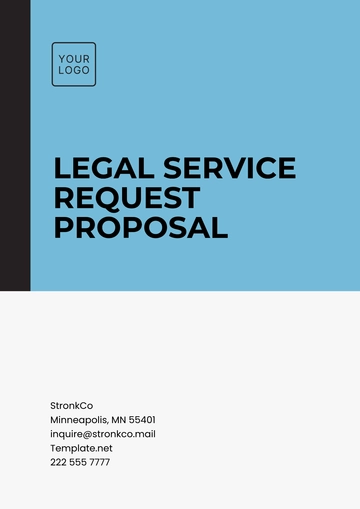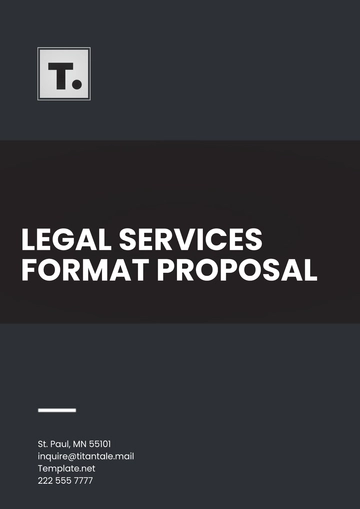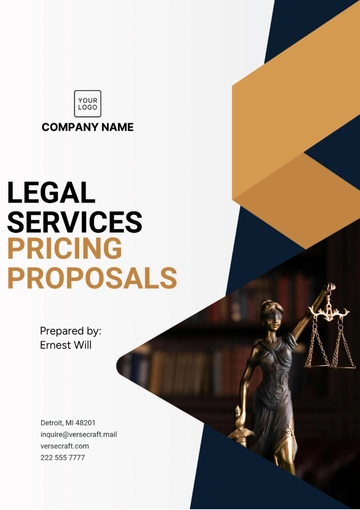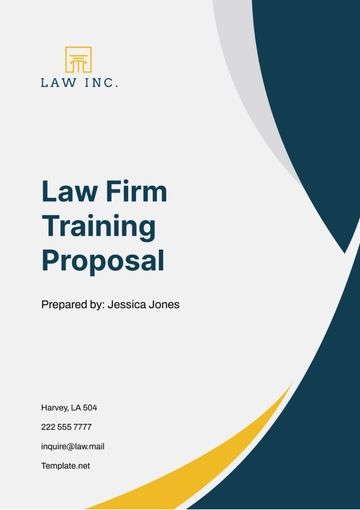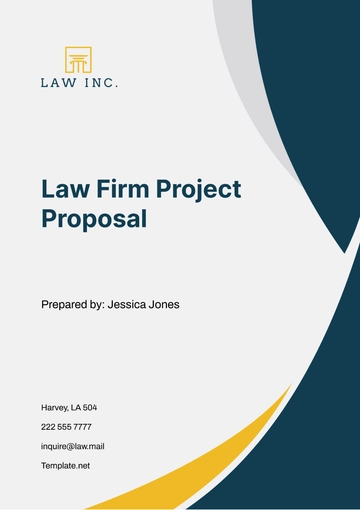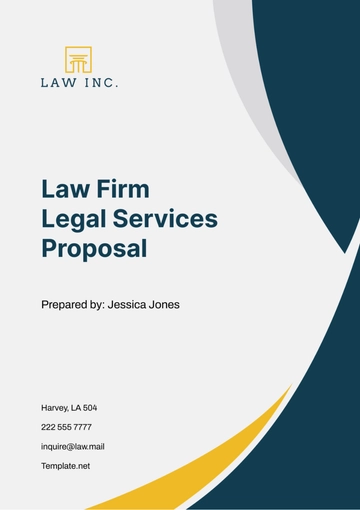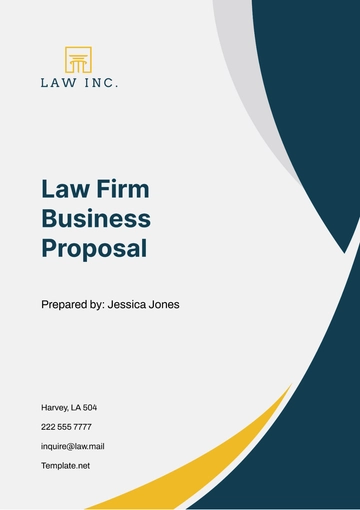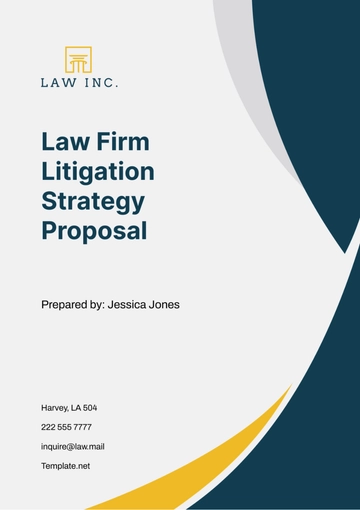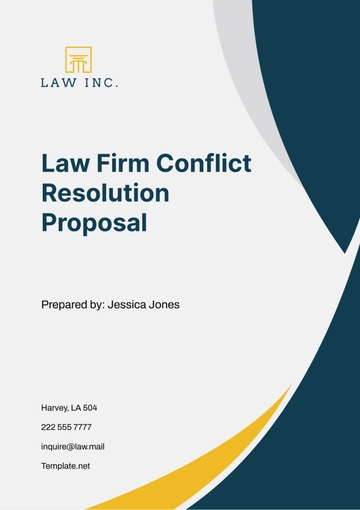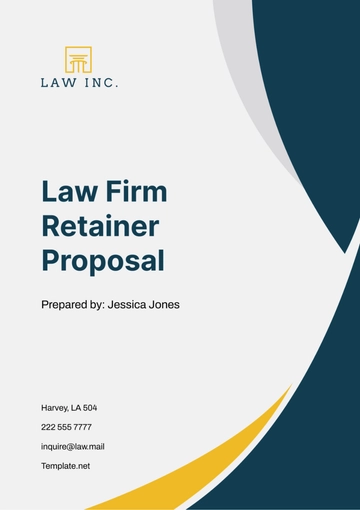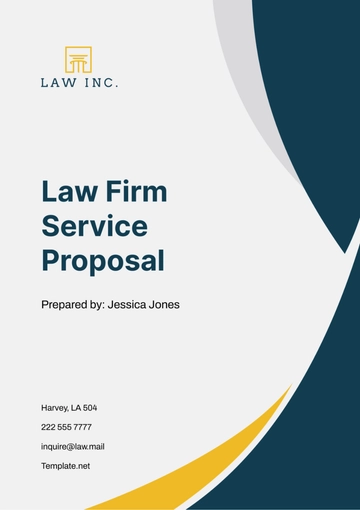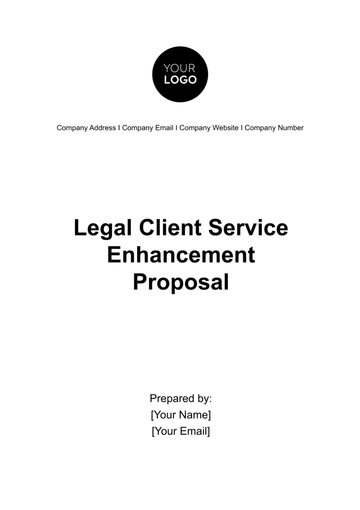Free Law Firm Conflict Resolution Proposal
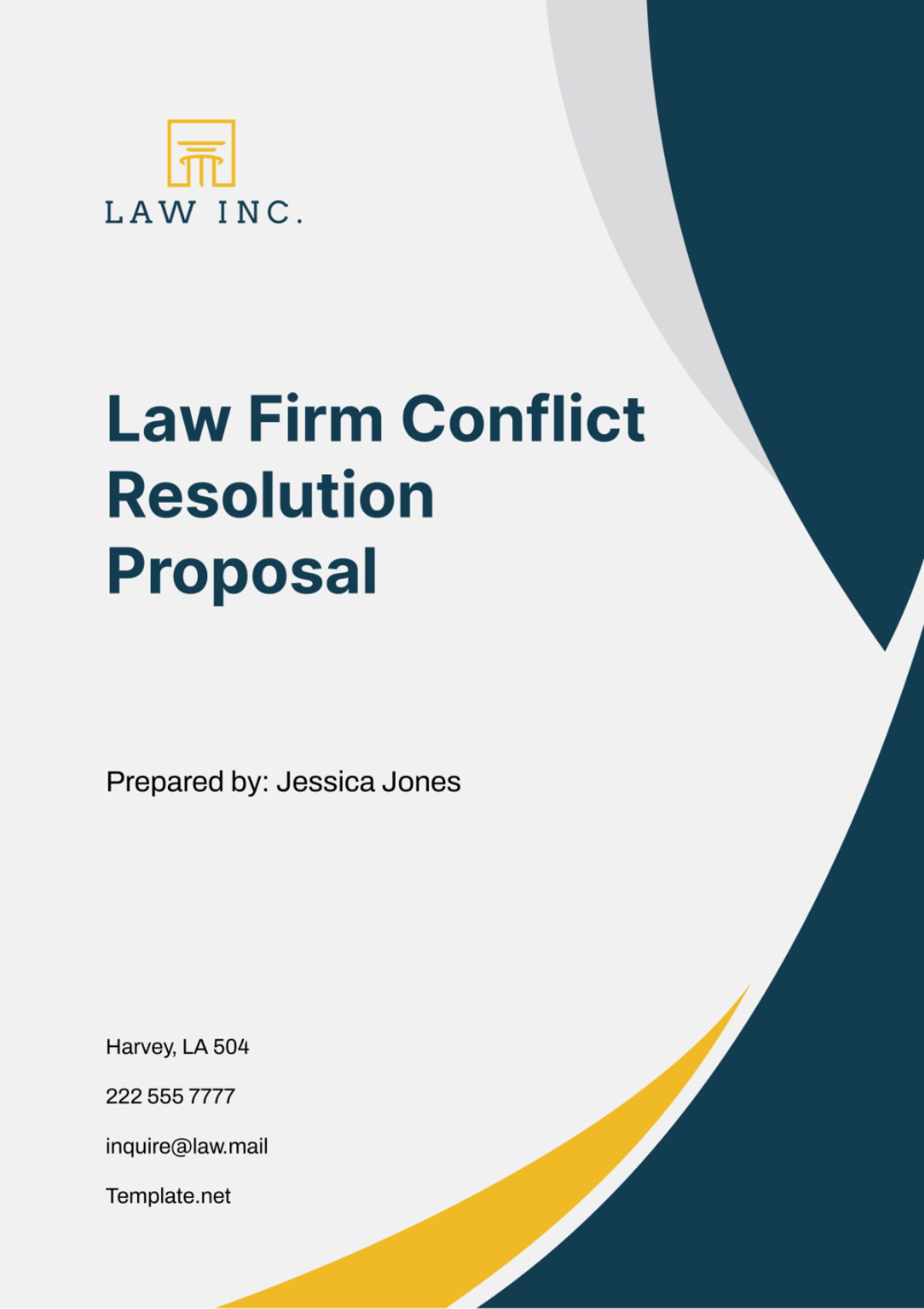
I. Executive Summary
This proposal presents a meticulously crafted strategy to manage and resolve internal conflicts at [Your Company Name]. Our approach emphasizes a framework that not only identifies potential disputes at their inception but also facilitates a timely and effective resolution. We are committed to fostering a harmonious workplace environment that adheres strictly to both legal requirements and the highest ethical standards. By implementing these measures, we aim to safeguard the integrity of our operations and maintain a productive, conflict-free work atmosphere.
In addition to preventive strategies, our proposal outlines a comprehensive conflict resolution process that integrates mediation and arbitration, tailored to the specific needs of [Your Company Name]. This ensures that all parties have the opportunity to be heard in a fair, impartial setting, thus enhancing trust and cooperation among team members. Our methodical approach is designed to resolve disputes swiftly and efficiently, minimizing disruption to our daily operations and aligning with our core values of respect and professionalism.
Moreover, the proposal includes continuous monitoring and evaluation mechanisms to assess the effectiveness of the conflict resolution strategies in place. This ongoing assessment allows for dynamic adjustments and improvements, ensuring that our approach remains relevant and effective in managing workplace disputes. By adhering to this structured conflict resolution plan, [Your Company Name] will uphold its reputation as a fair and equitable employer, committed to resolving internal disputes and fostering a supportive and respectful work environment.
II. Objectives
In this section, we delineate our strategic objectives designed to cultivate a robust framework for conflict resolution at [Your Company Name]. By setting clear, actionable goals, we aim to mitigate conflicts proactively, standardize resolution procedures, and ensure strict adherence to legal and ethical standards, thereby fostering a fair and harmonious workplace.
Clear Guidelines: We aim to establish transparent guidelines that delineate the steps and procedures for conflict resolution, ensuring that every team member understands how disputes are handled within the firm.
Preventive Measures: Our objective includes implementing proactive strategies that identify and address potential conflicts before they escalate, thereby reducing the frequency and severity of disputes.
Standardization of Processes: We seek to standardize our conflict resolution process to guarantee consistency, fairness, and impartiality across all cases, ensuring that every dispute is addressed through a uniform and predictable framework.
Compliance with Legal and Ethical Standards: A paramount objective is to ensure that all our conflict resolution efforts rigorously comply with applicable legal mandates and uphold the highest ethical standards, thus safeguarding our firm's integrity and professional reputation.
III. Methodology
The methodology section elaborates on our structured approach to refining and enhancing conflict resolution practices at [Your Company Name]. Our strategy involves a comprehensive assessment, consultation with experts, development of updated procedures, training on new protocols, and ongoing evaluation to ensure efficacy and adaptability.
Stage | Activity | Description |
|---|---|---|
Assessment of Current Policies | Policy Review | Conduct a thorough review of existing conflict resolution policies to identify areas needing improvement. |
Employee Feedback | Gather feedback from staff to understand the effectiveness and perceptions of current policies. | |
Consultation with Experts | Expert Engagement | Engage with conflict resolution professionals to gain insights and recommendations. |
Best Practices Review | Analyze industry best practices to benchmark our policies against top standards. | |
Development of Updated Procedures | Procedure Drafting | Develop updated conflict resolution procedures that incorporate expert advice and feedback. |
Policy Approval | Seek executive approval for the new procedures to ensure alignment with strategic objectives. | |
Training on New Protocols | Training Workshops | Organize comprehensive training sessions for all staff on the new conflict resolution protocols. |
Role-Playing Scenarios | Implement role-playing exercises to simulate conflict situations and practice new strategies. | |
Ongoing Monitoring and Evaluation | Performance Tracking | Regularly track the effectiveness of the newly implemented procedures through key performance indicators. |
Continuous Improvement | Continuously refine and adjust the conflict resolution strategies based on ongoing evaluations. |
This integrated methodology not only updates our conflict resolution mechanisms but also ensures they are deeply ingrained and effectively practiced across the organization, fostering a cohesive and professional workplace environment.
IV. Scope
This section details the comprehensive scope of our proposal for [Your Company Name], aimed at designing, implementing, and training staff in advanced conflict resolution procedures. Our focus is on updating existing policies to enhance our ability to manage both internal and external disputes effectively, ensuring our practices meet the highest standards of fairness and legal compliance.
Policy Design: We will create refined conflict resolution policies tailored to the unique dynamics of our firm, addressing both current and anticipated challenges.
Implementation Strategy: A detailed plan will be executed to integrate these new policies into daily operations, involving collaboration across all levels of the organization to ensure smooth adoption.
Training Programs: Comprehensive training sessions will be developed and delivered to all employees, equipping them with the skills and knowledge to apply the new procedures effectively.
Monitoring Mechanisms: Regular assessments will be conducted to monitor the effectiveness of the implemented policies, with adjustments made as necessary to ensure continuous improvement and compliance with evolving legal standards.
V. Timeline
The timeline for implementing the conflict resolution proposal at [Your Company Name] is structured to ensure meticulous planning, development, and execution of new procedures. This schedule is designed to facilitate a seamless transition to updated practices, with sufficient time allocated for training and thorough evaluation to maintain the highest standards of effectiveness and compliance.
Week | Activity | Details |
|---|---|---|
Week 1-2 | Initial Consultation and Planning | Convene meetings with key stakeholders to outline the project scope and gather input on current conflict resolution challenges. |
Week 3-4 | Development of Procedures | Draft new conflict resolution procedures incorporating feedback from initial consultations and best practice research. |
Week 5-6 | Staff Training | Conduct interactive training sessions across all departments to ensure understanding and readiness for new procedures. |
Week 7 | Implementation | Officially launch the new conflict resolution protocols firm-wide, with support structures in place for immediate assistance. |
Week 8-12 | Monitoring and Evaluation | Regularly assess the effectiveness of the new procedures through feedback and performance metrics, making adjustments as necessary. |
This timeline is crafted to guarantee a thorough approach, from initial planning through to the robust evaluation of outcomes, ensuring the newly implemented conflict resolution measures are both effective and sustainable.
VI. Budget
The budget for the conflict resolution proposal at [Your Company Name] is meticulously structured to cover all essential costs associated with the development and implementation of effective conflict resolution strategies. This detailed financial plan ensures that all activities from consultation to monitoring are well-funded, optimizing the overall success of the initiative.
Description | Cost Estimate | Details |
|---|---|---|
Consultation Fees | $5,000 - $10,000 | Costs associated with hiring external experts to provide insights and guidance on best practices. |
Training Sessions | $3,000 - $5,000 | Expenses for developing and delivering comprehensive training programs to staff. |
Documentation | $2,000 - $4,000 | Creation of detailed policy documents, procedure manuals, and support materials. |
Technology Implementation | $2,000 - $5,000 | Implementation of software or systems needed to support new conflict resolution processes. |
Monitoring and Evaluation | $1,000 - $3,000 | Costs for ongoing assessment tools and resources to evaluate the effectiveness of implemented strategies. |
This budget reflects our commitment to investing in a robust conflict resolution framework that aligns with the professional and ethical standards of [Your Company Name], ensuring a harmonious and productive work environment.
VII. Benefits and Impact
Implementing this proposal will significantly enhance the efficacy of conflict resolution mechanisms at [Your Company Name]. By adopting a structured approach, the frequency and severity of disputes will be minimized, thus reducing downtime and promoting a more efficient work process. An optimized conflict resolution process will directly contribute to increased productivity and foster a cooperative work environment, where employees feel safe and supported.
Furthermore, the proposal ensures compliance with legal standards and reduces the risks associated with poorly managed conflicts. By adhering to established legal and ethical guidelines, our firm will not only protect itself from potential legal liabilities but also uphold its reputation as a responsible and fair employer. This commitment to compliance and ethical practices will enhance our standing in the industry and build trust among stakeholders.
The overall working environment will see considerable improvements through the training and implementation of these updated conflict resolution procedures. Employees will be better equipped to handle disputes internally, which contributes to a more harmonious workplace atmosphere. This positive work environment will likely lead to higher employee satisfaction, reduced turnover rates, and an enhanced company image that attracts top talent. Each of these factors will contribute significantly to the long-term success and stability of [Your Company Name].
VIII. Risks and Mitigation Strategies
This section outlines potential risks associated with the implementation of the new conflict resolution policies at [Your Company Name] and details strategic measures to mitigate these risks. Recognizing and addressing these challenges proactively ensures the successful adoption and effectiveness of the conflict resolution framework, thereby safeguarding the firm's operational integrity and workplace harmony.
Risk | Mitigation Strategy | Details |
|---|---|---|
Resistance to Change Within Staff | Comprehensive Training and Clear Communication of Benefits | Implement detailed training sessions to educate staff on the advantages and necessity of the new policies. Engage with employees through open forums to address concerns and gather feedback. |
Inadequate Follow-Up | Regular Monitoring and Scheduled Evaluations | Establish a systematic schedule for monitoring the implementation and impact of the policies. Regular evaluations to assess effectiveness and make necessary adjustments. |
Over-Reliance on New Systems | Balance Between Automated Solutions and Human Judgment | While introducing new technologies for conflict resolution, ensure that decisions are also guided by experienced personnel to balance automation with human insight. |
Potential Cost Overruns | Rigorous Budget Management and Provision for Contingencies | Monitor expenditures closely against the allocated budget, with contingency funds in place to manage unexpected costs effectively. |
Data Privacy and Security Risks | Implementation of Robust Security Measures and Compliance with Data Protection Regulations | Secure all digital platforms used for conflict resolution. Regular audits to ensure compliance with the latest data protection laws. |
By meticulously addressing each identified risk with tailored mitigation strategies, [Your Company Name] not only enhances the resilience of its conflict resolution processes but also ensures a smoother transition and sustained benefits from the implementation of these critical initiatives.
IX. Stakeholder Engagement
This section details the critical role of engaging stakeholders throughout the implementation of the conflict resolution strategies at [Your Company Name]. Engaging stakeholders not only garners support but also ensures that the perspectives and insights of all parties are considered, leading to more robust and inclusive policies.
Stakeholder | Role in Project | Engagement Strategy |
|---|---|---|
Senior Management | Approval of policies and provision of resources | Regular briefings to keep them informed of progress and decisions, ensuring alignment with company goals. |
HR Department | Policy implementation and oversight | Workshops and collaborative sessions to refine policies and discuss implementation challenges. |
Employees | Directly affected by the changes | Surveys and focus groups to gather input on current issues and feedback on proposed solutions. |
Legal Advisors | Ensure compliance with legal standards | Consultations to review all policies for legal compliance and recommendations for improvements. |
IT Department | Support for technology implementation | Collaborative planning sessions to ensure technological needs for implementing policies are met. |
X. Project Sustainability
This section outlines strategies to ensure the long-term sustainability of the conflict resolution initiatives at [Your Company Name]. Sustaining these efforts is crucial for maintaining workplace harmony and continuous improvement in conflict management practices.
Element | Sustainability Strategy | Details |
|---|---|---|
Policy Updates | Regular reviews and revisions of conflict resolution policies | Scheduled policy reviews every six months to adapt to changes in the organizational environment and law. |
Training Refreshers | Ongoing training programs for new and existing staff | Annual refresher courses to reinforce practices and inform about any policy updates. |
Technology Upgrades | Continuous improvement of technological tools | Regular updates and security patches for software used in managing and reporting conflicts. |
Feedback Mechanisms | Consistent collection and analysis of feedback | Continuous feedback loops with stakeholders to refine processes and address new challenges. |
Resource Allocation | Dedicated budget for conflict resolution activities | Ensure financial and administrative resources are available to support ongoing conflict resolution efforts. |
These comprehensive strategies for stakeholder engagement and project sustainability are designed to embed the conflict resolution policies deeply within the organizational culture of [Your Company Name], promoting a durable and effective framework that evolves in line with both internal needs and external conditions.
- 100% Customizable, free editor
- Access 1 Million+ Templates, photo’s & graphics
- Download or share as a template
- Click and replace photos, graphics, text, backgrounds
- Resize, crop, AI write & more
- Access advanced editor
Enhance your law firm's conflict resolution strategies with Template.net's Law Firm Conflict Resolution Proposal template. Our customizable, professionally-designed template is editable in our AI Editor Tool, offering user-friendliness and flexibility. Improve your proposal's presentation, precision, and effectiveness. Gain an edge with our editable template, designed to simplify resolution processes, impress clients, and drive successful outcomes. Step up the conflict resolution game today with Template.net.
You may also like
- Business Proposal
- Research Proposal
- Proposal Request
- Project Proposal
- Grant Proposal
- Photography Proposal
- Job Proposal
- Budget Proposal
- Marketing Proposal
- Branding Proposal
- Advertising Proposal
- Sales Proposal
- Startup Proposal
- Event Proposal
- Creative Proposal
- Restaurant Proposal
- Blank Proposal
- One Page Proposal
- Proposal Report
- IT Proposal
- Non Profit Proposal
- Training Proposal
- Construction Proposal
- School Proposal
- Cleaning Proposal
- Contract Proposal
- HR Proposal
- Travel Agency Proposal
- Small Business Proposal
- Investment Proposal
- Bid Proposal
- Retail Business Proposal
- Sponsorship Proposal
- Academic Proposal
- Partnership Proposal
- Work Proposal
- Agency Proposal
- University Proposal
- Accounting Proposal
- Real Estate Proposal
- Hotel Proposal
- Product Proposal
- Advertising Agency Proposal
- Development Proposal
- Loan Proposal
- Website Proposal
- Nursing Home Proposal
- Financial Proposal
- Salon Proposal
- Freelancer Proposal
- Funding Proposal
- Work from Home Proposal
- Company Proposal
- Consulting Proposal
- Educational Proposal
- Construction Bid Proposal
- Interior Design Proposal
- New Product Proposal
- Sports Proposal
- Corporate Proposal
- Food Proposal
- Property Proposal
- Maintenance Proposal
- Purchase Proposal
- Rental Proposal
- Recruitment Proposal
- Social Media Proposal
- Travel Proposal
- Trip Proposal
- Software Proposal
- Conference Proposal
- Graphic Design Proposal
- Law Firm Proposal
- Medical Proposal
- Music Proposal
- Pricing Proposal
- SEO Proposal
- Strategy Proposal
- Technical Proposal
- Coaching Proposal
- Ecommerce Proposal
- Fundraising Proposal
- Landscaping Proposal
- Charity Proposal
- Contractor Proposal
- Exhibition Proposal
- Art Proposal
- Mobile Proposal
- Equipment Proposal
- Student Proposal
- Engineering Proposal
- Business Proposal
